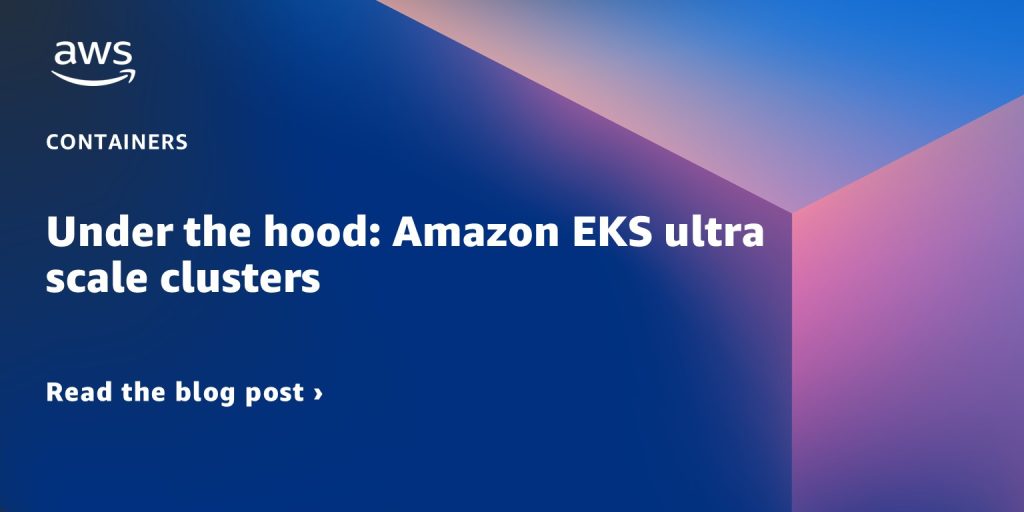Containers
Tag: open source
Under the hood: Amazon EKS ultra scale clusters
This post was co-authored by Shyam Jeedigunta, Principal Engineer, Amazon EKS; Apoorva Kulkarni, Sr. Specialist Solutions Architect, Containers and Raghav Tripathi, Sr. Software Dev Manager, Amazon EKS. Today, Amazon Elastic Kubernetes Service (Amazon EKS) announced support for clusters with up to 100,000 nodes. With Amazon EC2’s new generation accelerated computing instance types, this translates to […]
Introducing AI on EKS: powering scalable AI workloads with Amazon EKS
This blog post was jointly authored by Vara Bonthu, Principal OSS Specialist Solutions Architect and Omri Shiv, Senior Open Source ML Engineer Introduction We’re excited to announce the launch of AI on EKS: a new open source initiative from Amazon Web Services (AWS) designed to help customers deploy, scale, and optimize artificial intelligence/machine learning (AI/ML) […]
Automating AI-assisted container deployments with the Amazon ECS MCP Server
This blog post was jointly authored by Debasis Rath, Senior Solutions Architect – Serverless and Anton Aleksandrov, Principal Solutions Architect – Serverless Introduction Containerized applications have become the standard for modern cloud deployments, offering consistent environments, streamlined dependency management and seamless scaling. However, the process of containerizing and deploying applications remains manual and time-consuming. Builders […]
Optimizing data lakes with Amazon S3 Tables and Apache Spark on Amazon EKS
This blog post was authored by Aritra Gupta (Senior Product Manager – S3), Vara Bonthu (Principal, Open Source Software Specialist Solutions Architect), Ratnopam Chakrabarti (Senior Solutions Architect – Containers & Open Source Software), and Manabu McCloskey (Senior Open Source Engineer). Introduction Managing business data has become increasingly challenging as companies collect more information than ever […]
Accelerating application development with the Amazon EKS MCP server
This blog post was jointly authored by Niall Thomson, Principal Solutions Architect – Containers, Carlos Santana, Solutions Architect – Containers and George John, Senior Product Manager – Amazon EKS Introduction Today, we’re excited to announce the launch of the open source Model Context Protocol (MCP) server for Amazon Elastic Kubernetes Service (Amazon EKS). This new […]
Unlocking Benefits with Bottlerocket: A Purpose-Built Container OS
Post updated on Nov 26, 2024. This post discusses Bottlerocket, a Linux-based open source operating system that is purpose-built for running containers. We will walk through fleet management at scale and how users can benefit from it. We will also share the key pillars that support Bottlerocket’s development plan. The challenges of fleet management with […]
How Getir optimized their Amazon EKS compute using Karpenter
Introduction Getir is the pioneer of ultrafast grocery delivery. Getir was founded in 2015 and revolutionized last-mile delivery with its grocery in-minutes delivery proposition. Today, Getir is a conglomerate incorporating nine verticals under the same brand. Challenge Getir uses Amazon Elastic Kubernetes Service (Amazon EKS) to host applications on AWS. One of the foremost challenges […]
How HPE Aruba Networking modernized on Amazon EKS
This post was co-authored by Vignesh Senapathy, Principal DevOps Engineer, HPE. About Hewlett Packard Enterprise (HPE) Aruba Networking HPE Aruba Networking EdgeConnect Cloud Orchestrator is a cloud-native Software-Defined Wide Area Network (SD-WAN) orchestrator within HPE Aruba Networking’s portfolio. Serving as a centralized SD-WAN controller, it oversees both physical and virtual SD-WAN gateways throughout the enterprise […]
How CoStar uses Karpenter to optimize their Amazon EKS Resources
Introduction CoStar is well known as a market leader for Commercial Real Estate data, but they also run major home, rental, and apartments websites —including apartments.com—that many have seen advertised by Jeff Goldblum. CoStar’s traditional Commercial Real Estate customers are highly informed users that use large and complex data to make critical business decisions. Successfully […]
Multi-cluster cost monitoring for Amazon EKS using Kubecost and Amazon Managed Service for Prometheus
Introduction Amazon Managed Service for Prometheus is a Prometheus-compatible service that monitors and provides alerts on containerized applications and infrastructure at scale. In the previous post, Integrating Kubecost with Amazon Managed Service for Prometheus, we discussed how you can integrate Kubecost with Amazon Managed Service for Prometheus (AMP) to get granular visibility into your Amazon […]









